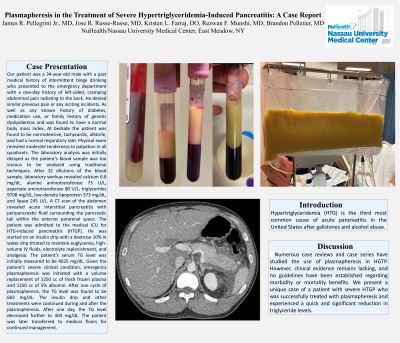Back

Poster Session B - Monday Morning
Category: Biliary/Pancreas
B0056 - Plasmapheresis in the Treatment of Severe Hypertriglyceridemia-Induced Pancreatitis: A Case Report
Monday, October 24, 2022
10:00 AM – 12:00 PM ET
Location: Crown Ballroom


James Pellegrini, MD
Nassau University Medical Center
East Meadow, New York
Presenting Author(s)
James Pellegrini, MD, Jose Russe-Russe, MD, Kristen Farraj, DO, Rezwan Munshi, MD, Brandon Pelletier, MD, Victoria Wang, BS, Anna Jinnah, BS
Nassau University Medical Center, East Meadow, NY
Introduction: Hypertriglyceridemia (HTG) is the third most common cause of acute pancreatitis in the United States after gallstones and alcohol abuse.
Case Description/Methods: Our patient was a 34-year-old male with a past medical history of intermittent binge drinking who presented to the emergency department with a one-day history of left-sided, cramping abdominal pain radiating to the back. He denied similar previous pain or any inciting incidents. As well as any known history of diabetes, medication use, or family history of genetic dyslipidemias and was found to have a normal body mass index. At bedside the patient was found to be normotensive, tachycardic, afebrile, and had a normal respiratory rate. Physical exam revealed moderate tenderness to palpation in all quadrants. The laboratory analysis was initially delayed as the patient’s blood sample was too viscous to be analyzed using traditional techniques. After 32 dilutions of the blood sample, laboratory workup revealed calcium 6.8 mg/dL, alanine aminotransferase 73 U/L, aspartate aminotransferase 80 U/L, triglycerides 9708 mg/dL, low-density lipoprotein 373 mg/dL, and lipase 245 U/L. A CT scan of the abdomen revealed acute interstitial pancreatitis with peripancreatic fluid surrounding the pancreatic tail within the anterior pararenal space. The patient was admitted to the medical ICU for HTG-induced pancreatitis (HTGP). He was started on an insulin drip with a dextrose 10% in water drip titrated to maintain euglycemia, high-volume IV fluids, electrolyte replenishment, and analgesia. The patient’s serum TG level was initially measured to be 4025 mg/dL. Given the patient’s severe clinical condition, emergency plasmapheresis was initiated with a volume replacement of 1250 cc of fresh frozen plasma and 1250 cc of 5% albumin. After one cycle of plasmapheresis, the TG level was found to be 603 mg/dL. The insulin drip and other treatments were continued during and after the plasmapheresis. After one day, the TG level decreased further to 304 mg/dL. The patient was later transferred to medical floors for continued management.
Discussion: Numerous case reviews and case series have studied the use of plasmapheresis in HGTP. However, clinical evidence remains lacking, and no guidelines have been established regarding morbidity or mortality benefits. We present a unique case of a patient with severe HTGP who was successfully treated with plasmapheresis and experienced a quick and significant reduction in triglyceride levels.

Disclosures:
James Pellegrini, MD, Jose Russe-Russe, MD, Kristen Farraj, DO, Rezwan Munshi, MD, Brandon Pelletier, MD, Victoria Wang, BS, Anna Jinnah, BS. B0056 - Plasmapheresis in the Treatment of Severe Hypertriglyceridemia-Induced Pancreatitis: A Case Report, ACG 2022 Annual Scientific Meeting Abstracts. Charlotte, NC: American College of Gastroenterology.
Nassau University Medical Center, East Meadow, NY
Introduction: Hypertriglyceridemia (HTG) is the third most common cause of acute pancreatitis in the United States after gallstones and alcohol abuse.
Case Description/Methods: Our patient was a 34-year-old male with a past medical history of intermittent binge drinking who presented to the emergency department with a one-day history of left-sided, cramping abdominal pain radiating to the back. He denied similar previous pain or any inciting incidents. As well as any known history of diabetes, medication use, or family history of genetic dyslipidemias and was found to have a normal body mass index. At bedside the patient was found to be normotensive, tachycardic, afebrile, and had a normal respiratory rate. Physical exam revealed moderate tenderness to palpation in all quadrants. The laboratory analysis was initially delayed as the patient’s blood sample was too viscous to be analyzed using traditional techniques. After 32 dilutions of the blood sample, laboratory workup revealed calcium 6.8 mg/dL, alanine aminotransferase 73 U/L, aspartate aminotransferase 80 U/L, triglycerides 9708 mg/dL, low-density lipoprotein 373 mg/dL, and lipase 245 U/L. A CT scan of the abdomen revealed acute interstitial pancreatitis with peripancreatic fluid surrounding the pancreatic tail within the anterior pararenal space. The patient was admitted to the medical ICU for HTG-induced pancreatitis (HTGP). He was started on an insulin drip with a dextrose 10% in water drip titrated to maintain euglycemia, high-volume IV fluids, electrolyte replenishment, and analgesia. The patient’s serum TG level was initially measured to be 4025 mg/dL. Given the patient’s severe clinical condition, emergency plasmapheresis was initiated with a volume replacement of 1250 cc of fresh frozen plasma and 1250 cc of 5% albumin. After one cycle of plasmapheresis, the TG level was found to be 603 mg/dL. The insulin drip and other treatments were continued during and after the plasmapheresis. After one day, the TG level decreased further to 304 mg/dL. The patient was later transferred to medical floors for continued management.
Discussion: Numerous case reviews and case series have studied the use of plasmapheresis in HGTP. However, clinical evidence remains lacking, and no guidelines have been established regarding morbidity or mortality benefits. We present a unique case of a patient with severe HTGP who was successfully treated with plasmapheresis and experienced a quick and significant reduction in triglyceride levels.

Figure: Blood samples from patient
Disclosures:
James Pellegrini indicated no relevant financial relationships.
Jose Russe-Russe indicated no relevant financial relationships.
Kristen Farraj indicated no relevant financial relationships.
Rezwan Munshi indicated no relevant financial relationships.
Brandon Pelletier indicated no relevant financial relationships.
Victoria Wang indicated no relevant financial relationships.
Anna Jinnah indicated no relevant financial relationships.
James Pellegrini, MD, Jose Russe-Russe, MD, Kristen Farraj, DO, Rezwan Munshi, MD, Brandon Pelletier, MD, Victoria Wang, BS, Anna Jinnah, BS. B0056 - Plasmapheresis in the Treatment of Severe Hypertriglyceridemia-Induced Pancreatitis: A Case Report, ACG 2022 Annual Scientific Meeting Abstracts. Charlotte, NC: American College of Gastroenterology.

